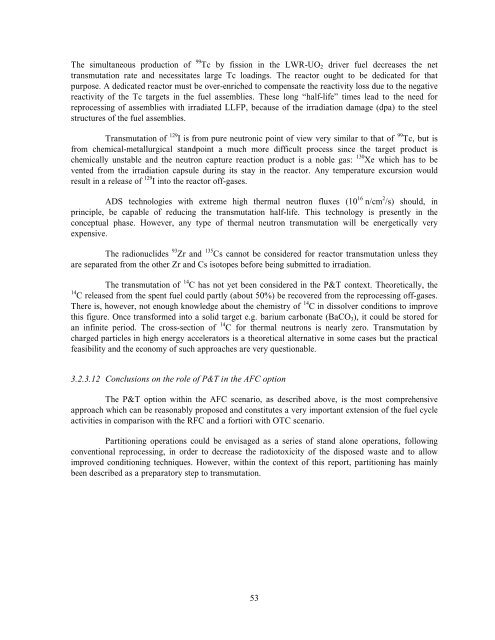COMPLETE DOCUMENT (1862 kb) - OECD Nuclear Energy Agency
COMPLETE DOCUMENT (1862 kb) - OECD Nuclear Energy Agency
COMPLETE DOCUMENT (1862 kb) - OECD Nuclear Energy Agency
You also want an ePaper? Increase the reach of your titles
YUMPU automatically turns print PDFs into web optimized ePapers that Google loves.
The simultaneous production of 99 Tc by fission in the LWR-UO 2 driver fuel decreases the net<br />
transmutation rate and necessitates large Tc loadings. The reactor ought to be dedicated for that<br />
purpose. A dedicated reactor must be over-enriched to compensate the reactivity loss due to the negative<br />
reactivity of the Tc targets in the fuel assemblies. These long “half-life” times lead to the need for<br />
reprocessing of assemblies with irradiated LLFP, because of the irradiation damage (dpa) to the steel<br />
structures of the fuel assemblies.<br />
Transmutation of 129 I is from pure neutronic point of view very similar to that of 99 Tc, but is<br />
from chemical-metallurgical standpoint a much more difficult process since the target product is<br />
chemically unstable and the neutron capture reaction product is a noble gas: 130 Xe which has to be<br />
vented from the irradiation capsule during its stay in the reactor. Any temperature excursion would<br />
result in a release of 129 I into the reactor off-gases.<br />
ADS technologies with extreme high thermal neutron fluxes (10 16 n/cm 2 /s) should, in<br />
principle, be capable of reducing the transmutation half-life. This technology is presently in the<br />
conceptual phase. However, any type of thermal neutron transmutation will be energetically very<br />
expensive.<br />
The radionuclides 93 Zr and 135 Cs cannot be considered for reactor transmutation unless they<br />
are separated from the other Zr and Cs isotopes before being submitted to irradiation.<br />
The transmutation of 14 C has not yet been considered in the P&T context. Theoretically, the<br />
14 C released from the spent fuel could partly (about 50%) be recovered from the reprocessing off-gases.<br />
There is, however, not enough knowledge about the chemistry of 14 C in dissolver conditions to improve<br />
this figure. Once transformed into a solid target e.g. barium carbonate (BaCO 3 ), it could be stored for<br />
an infinite period. The cross-section of 14 C for thermal neutrons is nearly zero. Transmutation by<br />
charged particles in high energy accelerators is a theoretical alternative in some cases but the practical<br />
feasibility and the economy of such approaches are very questionable.<br />
3.2.3.12 Conclusions on the role of P&T in the AFC option<br />
The P&T option within the AFC scenario, as described above, is the most comprehensive<br />
approach which can be reasonably proposed and constitutes a very important extension of the fuel cycle<br />
activities in comparison with the RFC and a fortiori with OTC scenario.<br />
Partitioning operations could be envisaged as a series of stand alone operations, following<br />
conventional reprocessing, in order to decrease the radiotoxicity of the disposed waste and to allow<br />
improved conditioning techniques. However, within the context of this report, partitioning has mainly<br />
been described as a preparatory step to transmutation.<br />
53
















